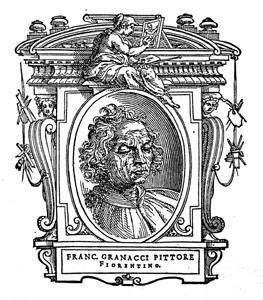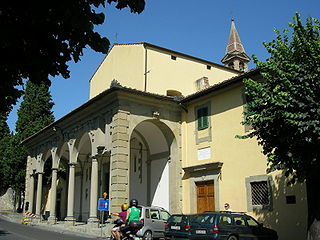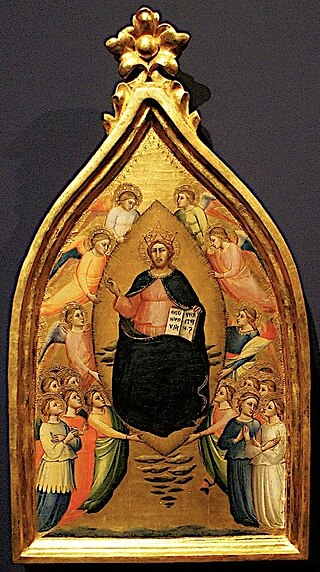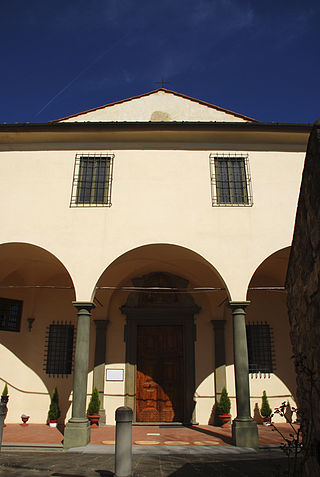
Fra Angelico, OP was a Dominican friar and Italian Renaissance painter of the Early Renaissance, described by Giorgio Vasari in his Lives of the Artists as having "a rare and perfect talent". He earned his reputation primarily for the series of frescoes he made for his own friary, San Marco, in Florence, then worked in Rome and other cities. All his known work is of religious subjects.

Domenico di Michelino (1417–1491) was an Italian Renaissance painter who was born and died in Florence. His birth name was Domenico di Francesco. The patronymic "di Michelino" was adopted in honour of his teacher, the cassone painter Michelino di Benedetto, by whom no works have been identified. Giorgio Vasari reports that Domenico was also a pupil of Fra Angelico, whose influence is reflected in many of Domenico's paintings along with that of Filippo Lippi and Pesellino.

Pietro Perugino, an Italian Renaissance painter of the Umbrian school, developed some of the qualities that found classic expression in the High Renaissance. Raphael became his most famous pupil.

Empoli is a town and comune in the Metropolitan City of Florence, Tuscany, Italy, about 30 km southwest of Florence, to the south of the Arno in a plain formed by the river. The plain has been usable for agriculture since Roman times. The commune's territory becomes hilly as it departs from the river. Empoli is on the main railway line from Florence to Pisa, and is the point of divergence of a line to Siena. Empoli has an enduring tradition as an agricultural centre. It has given its name to a local variety of artichoke.

Poggibonsi is a town in the province of Siena, Tuscany, central Italy. It is located on the River Elsa and is the main centre of the Valdelsa Valley.

Francesco Granacci was an Italian Renaissance painter active primarily in his native Florence. Though little-known today, he was regarded in his time and is featured in Giorgio Vasari's Lives of the Artists.

Giovanni Antonio Sogliani was an Italian painter of the Renaissance, active mainly in Florence.

Lorenzo di Niccolò or Lorenzo di Niccolò di Martino was an Italian painter who was active in Florence from 1391 to 1412. This early Renaissance artist worked in the Trecento style, and his work maintains influences of the Gothic style, marking a transitional period between the Gothic sensibilities of the Middle Ages while simultaneously beginning to draw on the Classical. Lorenzo's works were usually religious scenes in tempera with gold backgrounds.

Santa Maria Maddalena dei Pazzi is a Renaissance-style Roman Catholic church and a former convent located in Borgo Pinti in central Florence, Italy.

The Madonna dell'Orto is a church in Venice, Italy, in the sestiere of Cannaregio. This was the home parish of Tintoretto and holds a number of his works as well as his tomb.

The Convent of San Domenico is a Dominican convent in Fiesole, Italy, situated between the hill of Fiesole and the suburbs of Florence. It was founded in 1406 and completed in 1435 on the initiative of Giovanni Dominici and the bishop of Fiesole, Jacopo Altoviti, both of them friars at the Basilica of Santa Maria Novella in Florence.

The Madonna and Child Enthroned with Saints John the Baptist and Sebastian is a painting by the Italian Renaissance artist Pietro Perugino, executed in 1493 and housed in the Uffizi Gallery, Florence.

The Fiesole Altarpiece is a painting by the Italian early Renaissance master Fra Angelico, executed around 1424–1425. It is housed in the Convent of San Domenico, Fiesole, central Italy. The background was repainted by Lorenzo di Credi in 1501.

Mariotto di Nardo di Cione was a Florentine painter in the Florentine Gothic style. He worked at the Duomo of Florence, the church of Santa Maria Maggiore, and the Orsanmichele. He created both frescoes and panel paintings, and was also active as a manuscript illuminator.

Giovanni di Ser Giovanni, also known as Lo Scheggia, or "the Splinter" was an Italian Renaissance painter in Florence who was born in San Giovanni Valdarno and was the younger brother of the famous Masaccio.

San Barnaba is a Roman Catholic church located at the intersection of Via Giovanni Chiassi and Via Carlo Poma in Mantua, Lombardy, Italy.

The Minor Basilica of Santi Vicenzo e Caterina de' Ricci is a Catholic church, built in the 16th to 18th centuries, and located in the town of Prato, in Tuscany, Italy. Adjacent to the church is a 16th-century monastery.

San Francesco is a Romanesque and Gothic-style, Roman Catholic church located at Piazza San Francesco in Pescia, region of Tuscany, Italy.

The church of San Giorgio alla Costa, called in earlier times also dei Santi Giorgio e Massimiliano dello Spirito Santo is a small historical church in the Oltrarno district of the centre of Florence, situated on the steep slope of via Costa San Giorgio which runs uphill from Ponte Vecchio to Forte di Belvedere.

Santa Maria della Neve al Portico is a Roman Catholic church and convent located on a rural site on Via del Podestà #86 in the suburban neighborhood of Galluzzo southeast of the urban center of Florence, Italy. It remains a monastery and is also known as the Convento Il Portico and now houses the Istituti Religiosi Femminili Suore Stimmatine.




















